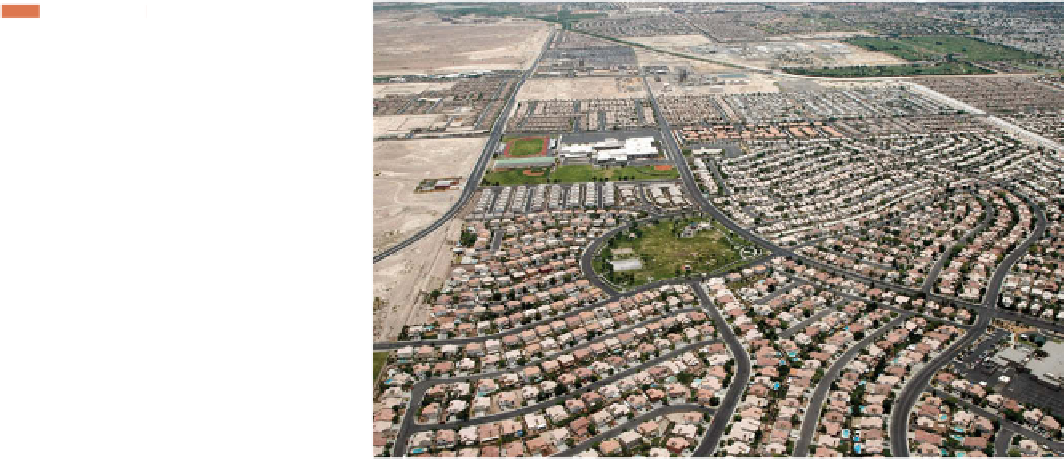Geography Reference
In-Depth Information
Figure 9.36
Henderson, Nevada.
Henderson is the
largest suburb of Las Vegas, and it was also
the fastest-growing urban settlement in the
United States between 1990 and 2000. Many
of the houses in this photograph are empty
today, as Las Vegas has been fi rst or second
in the number of home and rental vacan-
cies in United States cities in 2009 and 2010.
© Ethan Miller/Getty Images.
you can walk where you need to go or take the T (metro).
Places are built up vertically, and curving, narrow streets
and commercial developments with a fl avor of the old city
(Quincy Market) give the city a cozy, int
New urbanists want to create neighborhoods that promote
a sense of community and a sense of place.
The most famous new urbanist projects are cit-
ies that new urbanists designed from the ground up,
including Seaside, Florida (featured in the movie
The
Truman Show
), West Laguna, California, and Kentlands,
Maryland. When new urbanists build a town, the design
is reminiscent of Christaller over a much smaller area.
The planners choose the central shopping areas and open
spaces and develop the neighborhoods around them, with
housing clustered around the central space, so that people
can walk to the shopping area within fi ve minutes. One
goal of new urbanist designs is to build housing more
densely, to take up less space. Along with that, making
shopping and other amenities walkable decreases depen-
dency on the automobile, in the process helping the envi-
ronment.
Although some see new urbanist designs as manu-
factured communities and feel disconnected in a new
urbanist space, others see these designs as superior to
sprawl. Celebration, Florida, is a remarkable new urban-
ist space: it is adjacent to Walt Disney's theme parks, was
envisioned by Walt Disney himself, and is owned by the
Disney Company (Fig. 9.37). Built in 1994, Celebration
is centered on Market Street, a shopping district with res-
taurants (including a 1950s-style diner and a pizza place),
a town hall, banks, a post offi ce, and a movie theater with a
nostalgic marquee (Fig. 9.38). The town includes schools,
a health center, a fi tness center, and churches. The Disney
Company chose certain architectural styles for the houses
in Celebration, and builders offer homes and townhouses
in a price range from $300,000 to over $1 million. To meet
the new urbanist goal of incorporating diverse people in a
community, Celebration includes apartments for rent and
condominiums for sale.
imate feel.
Does population growth explain which cities expe-
rience the most urban sprawl? In a study of sprawl from
1960 through the 1990s, Leon Kolankiewicz and Roy Beck
(two antisprawl writers) used United States Census data on
urbanized areas and found that urban sprawl happened even
in urban areas without signifi cant population growth. In
the United States, urban sprawl is more rampant in the Sun
Belt of the South (Atlanta) and in the West (Houston) in
urban areas whose population is rapidly growing (Table 9.1).
Yet, even in cities such as Detroit and Pittsburgh, where
urban populations fell during the study period—by 7 per-
cent in Detroit and 9 percent in Pittsburgh—urban sprawl
increased the urbanized areas of the cities by 28 percent and
30 percent, respectively. For urban sprawl to happen, farm-
lands and old industrial sites are razed, and roads are built or
widened, strip malls are erected, and housing developments
monopolize the horizon.
To counter urban sprawl, a group of architects, urban
planners, and developers (now numbering over 2000 in
more than 20 countries) outlined an urban design vision
they call new urbanism. Forming the Congress for the
New Urbanism in 1993, the group defi nes
new urban-
ism
as development, urban revitalization, and subu
rban
reforms that create walkable neighborhoods with a diver-
sity of housing and jobs. On their website, the Congress for
the New Urbanism explains that “New Urbanists support
regional planning for open space, appropriate architecture
and planning, and the balanced development of jobs and
housing. They believe these strategies are the best way to
reduce how long people spend in traffi c, to increase the
supply of affordable housing, and to rein in urban sprawl.”










































